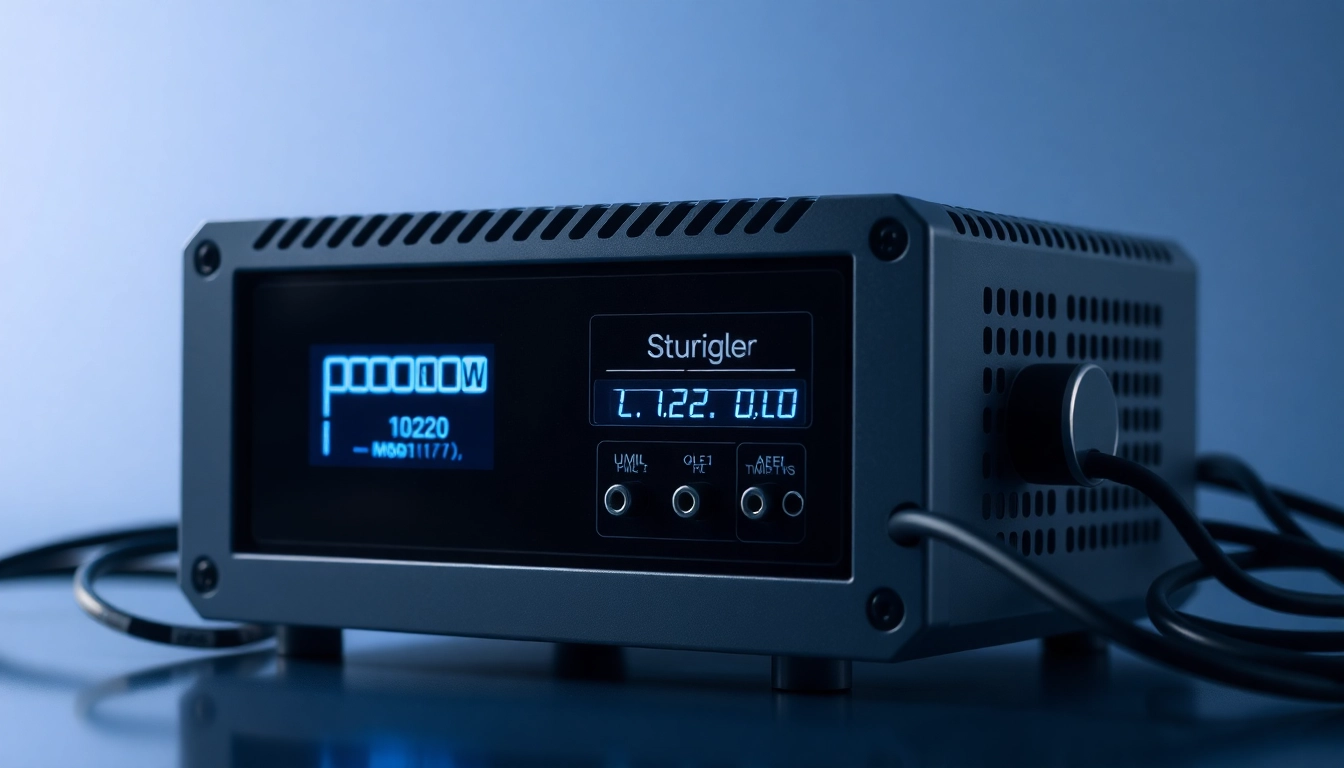Introduction to Power Supply Manufacturers
Power supplies are critical components within a myriad of electronic systems, responsible for converting and regulating power to ensure optimal performance and safety. The demand for reliable and efficient power supply solutions is escalating, as both industrial and consumer applications increasingly depend on robust power management. As a result, the role of a Power Supply Manufacturer becomes paramount in delivering high-quality products that meet various operational requirements and standards.
Understanding Power Supply Types
Power supplies can be categorized into several types based on their function and application, including AC-DC power supplies, DC-DC converters, uninterruptible power supplies (UPS), and linear power supplies. Each type serves specific needs and varies significantly in design and performance:
- AC-DC Power Supplies: Convert alternating current (AC) to direct current (DC), most often used in consumer electronics.
- DC-DC Converters: Transform one DC voltage level to another, essential for battery-powered devices to maximize efficiency.
- Uninterruptible Power Supplies (UPS): Provide backup power during outages, crucial for data centers and critical systems where uptime is non-negotiable.
- Linear Power Supplies: Offer high power quality, often preferred in audio devices, albeit less efficient than switching power supplies.
Importance of Quality Power Supply Manufacturers
The quality of power supplies influences the reliability and performance of the entire system. In contexts like industrial automation, telecommunications, and IT infrastructure, a subpar power supply can lead to system failures, data loss, and increased operational costs. Therefore, selecting a reputable power supply manufacturer ensures that products are compliant with international standards, have undergone rigorous testing, and offer support for future upgrades. Quality power supply manufacturers implement strict quality controls, such as ISO certifications, ensuring that their products consistently meet high-performance thresholds.
Key Industry Standards and Certifications
Various international standards govern the manufacturing and performance of power supplies, ensuring safety and reliability. Key certifications include:
- ISO 9001: Indicates a commitment to quality management principles and customer satisfaction.
- IEC 60950: Pertains to safety requirements for information technology equipment.
- UL Certification: Ensures safety standards are met, particularly in the North American market.
Compliance with these standards instills confidence in manufacturers’ products, making them more attractive to potential buyers.
Leading Power Supply Manufacturers in the Market
Overview of Top Players
The power supply market is populated with established manufacturers renowned for their innovation and reliability. Some of the leaders include:
- Mean Well: Known for its vast product range and standards-compliant power supplies, covering outputs from 0.5W to 25,600W, catering to a spectrum of industries.
- XP Power: Offers a wide array of AC-DC power supplies and DC-DC converters, recognized for their efficient designs and commitment to sustainability.
- FSP Group: Global leader in power supply solutions, particularly known for their modular power supplies and energy efficiency.
- Wall Industries: A veteran in the field, manufacturing high-quality power products since 1961, focusing on customer-driven solutions.
Market Share and Trends
As the demand for power supply solutions continues to grow, so do the competitive dynamics of the market. Key trends influencing market share include:
- Sustainability Initiatives: Consumers and industries now prioritize energy efficiency and eco-friendly manufacturing processes, driving manufacturers to innovate accordingly.
- Smart Power Supplies: With the rise of IoT and smart technology, manufacturers are developing smart power solutions that offer real-time monitoring and control.
Market players that can capitalize on these trends stand to gain significant market share as both companies and consumers shift their purchasing criteria towards energy efficiency and technological integration.
Product Comparisons and Features
When comparing power supply products, key features to consider include efficiency ratings, form factor, input voltage range, and output voltage adjustability:
- Efficiency Ratings: Power supplies are often rated with an efficiency certification, such as 80 PLUS, which denotes how effectively they convert input power to output power.
- Form Factor: The physical size and mounting type (internal, external, or modular) must align with the intended application environment.
- Input Voltage Range: Ensures compatibility with different power sources, critical for global operations.
- Output Voltage Adjustability: Provides flexibility to adapt to various load requirements and operational conditions.
A thorough analysis of these features aids in establishing which power supply manufacturer meets the specific needs of a project or application effectively.
Choosing the Right Power Supply Manufacturer
Factors to Consider for Quality Assurance
Selecting the right power supply manufacturer requires careful evaluation of several factors, including:
- Product Range: Ensure the manufacturer offers products that align with your specific power requirements and application needs.
- Quality Control Measures: Investigate their quality assurance practices, including testing protocols and how they respond to product failures or recalls.
- Customer Support: Reliable customer support and technical assistance can dramatically enhance the longevity and performance of the products utilized.
Assessing Manufacturer Reputation and Experience
A manufacturer’s reputation directly correlates with their reliability and the longevity of their products. Industry experience provides additional insight into their knowledge of power supply technologies and system integration.
To assess reputation, consider researching company history, customer feedback, and industry accolades. Participation in trade shows and certifications can also highlight their standing within the industry.
Customer Reviews and Case Studies
Engaging with existing users of a manufacturer’s products can provide essential insights that may not be apparent through marketing material. Case studies particularly illustrate how specific products performed in real-world applications, offering an invaluable perspective on durability and reliability.
Companies often showcase testimonials and success stories, allowing prospective buyers to gauge satisfaction levels and potential issues. Consider reaching out to industry forums and social media platforms for user opinions to gather diverse insights.
The Future of Power Supply Manufacturing
Trends in Power Supply Technology
Viewing the landscape of power supply manufacturing reveals an exciting horizon characterized by rapid advancements in technology and increased integration with next-gen systems. Key trends include:
- Integration of Digital Management: Digital controls enhance the functionality of power supplies, allowing for remote monitoring and adjustments via software interfaces.
- Power Density Improvement: Manufacturers strive for smaller, lighter designs that offer higher power output, accommodating compact electronic devices while maximizing efficiency.
Environmental Considerations in Manufacturing
Sustainability has become a crucial aspect of power supply design and manufacturing. Initiatives include using recyclable materials, reducing waste in production, and focusing on energy-efficient technologies. Manufacturers are also increasingly assessed on their environmental impact as consumers and regulatory entities push for sustainable practices.
Innovations and Disruptions in the Industry
As digital technology continues to evolve, innovators in the power supply space are exploring new methodologies such as:
- Advanced Power Management Solutions: These include power supplies that adapt dynamically to load changes, optimizing their output in real time.
- Battery Technology Integration: Innovating hybrid products that combine traditional power conversion with battery management systems to offer seamless energy solutions.
Conclusion and Recommendations
Summary of Key Takeaways
Understanding the landscape of power supply manufacturing entails recognizing the importance of quality, long-standing reputable manufacturers, and up-to-date technological advancements. Selecting a power supply appropriately aligned with your operational needs can yield significant performance improvements and cost savings over time.
Choosing the Best Supplier for Your Needs
When considering a supplier, evaluate the factors discussed, from product features and quality certifications to manufacturer reputation and user reviews. A balanced approach ensures purchasing decisions are made with confidence and clarity.
Resources for Further Research
For those looking to delve deeper into the power supply market, resources such as industry reports, product catalogs from leading manufacturers, and engagement with forums and professional networks can enhance understanding and enable informed choices regarding power supply systems.



